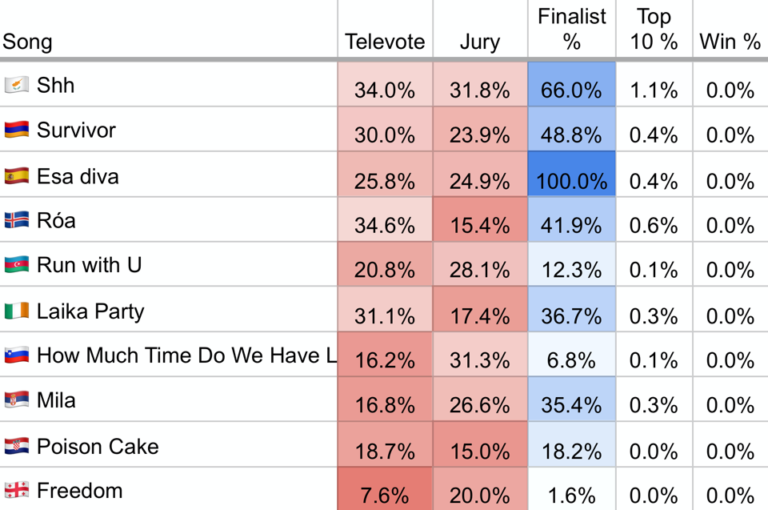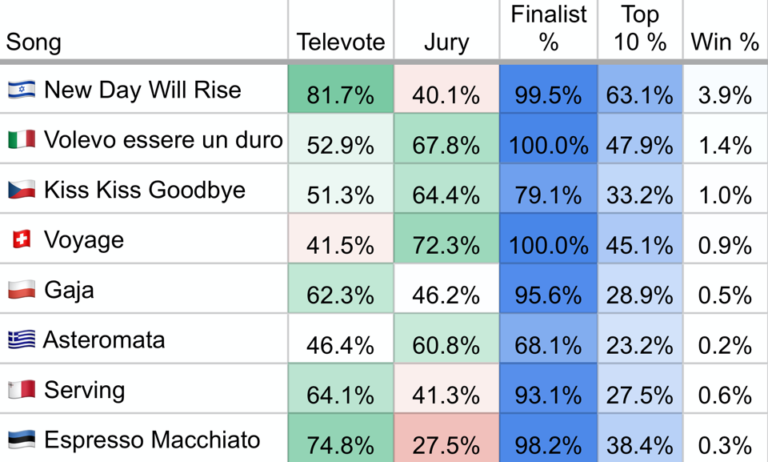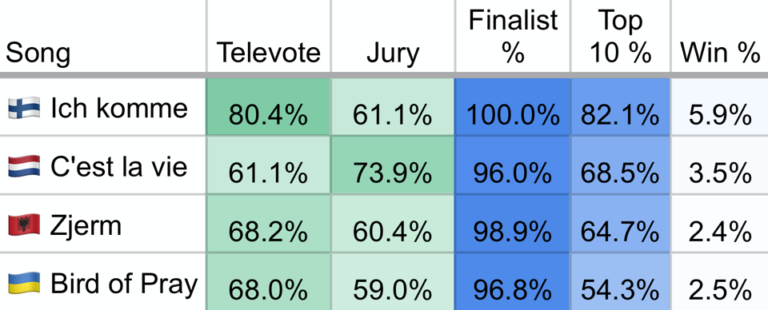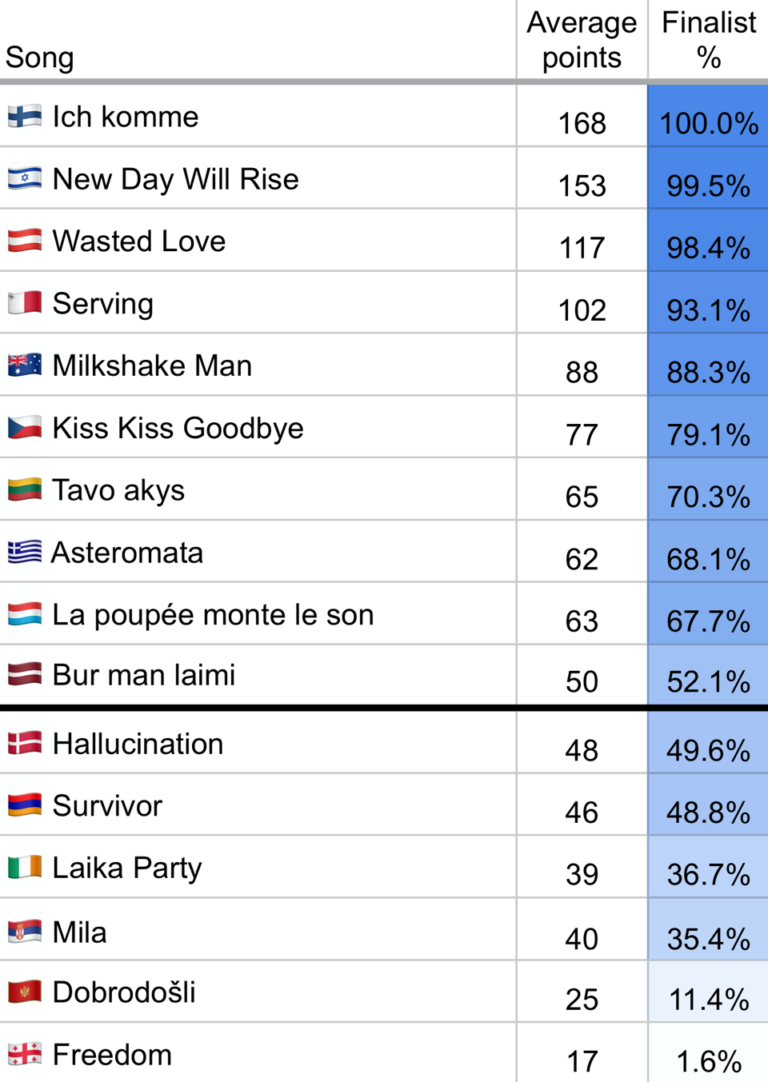There are few things that the Eurovision Song Contest community loves more than sharing their prediction. Who will win? Who is making it out of the Semi Finals? Who is going to surprise? Who will be the shock?
How This Is Going To Work
Some make their predictions based on their own assessments of the songs; “what sounds like a winner?” Others, notably Eurovoix’s ‘The Model’, try to make an informed guess by looking at everything from historical data to performances in odds and fan rankings to internal music statistics of each song.
Last year, I wanted to launch a new, crowd-sourced model that could give a detailed view of each entry’s prospects. More specifically, to gauge the potential of each of the 37 entries, I ran a survey asking Eurovision fans to place the entries on a 0 to 100 scale for both televote and jury… a ‘0’ indicates the song would finish last with all countries in a hypothetical final, while ‘100’ indicates it would finish first with all.
Based on the average values of these predictions and their variation, I simulated 100,000 Song Contests, each with slight adjustments being made to each entry’s values to reflect the likelihood of them over- and underperforming expectations. In addition, data from the Contests going back to 2014 was used to implement realistic diaspora voting and running order effects.
What Happened In 2024?
Last year, this method managed to produce surprisingly accurate results, getting nine of the ten qualifiers in both Semi Finals, and putting Nemo at a 17.1 percent win chance. This was during a period where the odds had them around 10 percent. With those results in mind, I decided it was worthwhile to run the simulation for 2025 with the help of 289 Eurofans who offered their predictions.
While the simulations do not provide a crystal clear winner, they do showcase clear dynamics of the Contest, and the perspectives of each song.

Community appeal of Estonia 2025 and Switzerland 2025 (image: Dane Jorgensen)
Six Groups In Search Of A Victory
You can risk getting a fragmented response while asking 289 people for their opinions on anything. In general, the Eurovision predictions were quite consistent between predictors. Just take a look at how the responses of ‘Espresso Macchiato’ and ‘Voyage’ clearly reflect the lopsided appeals of each entry.
Looking at the results of all 100,000 simulations, the 37 entries can be divided into six groups: The underdogs, the peloton, the outsiders, the specialists, the dark horses, and the frontrunners. Let’s take a closer look at each group and what sets their entries apart.
The Underdogs
This group consists of the songs with the lowest expectations. None of the songs exceed the 35 percent mark in any category, indicating that they would struggle to earn serious points in either the jury or the televote should they make the Grand Final. Despite this, we will likely still see some of them making Saturday night with an average of 3.7 finalists coming from this group (including the prequalified Spain). But reaching the Top Ten looks like a step too far for our underdogs.

Eurovision 2025 Simulation, The Underdogs (Image: Dolphin Dane)
The Peloton
Named after the main group of cyclists in road races such as the Tour De France, these songs set themselves apart from the underdogs by scoring above 45 percent in one of the voting groups. This means that while they may not be candidates for any high finishes, they will likely earn enough points to avoid the very bottom should they make the Grand Final. While left-side-of-the-scoreboard placements are not completely out of the question for these songs, they will face a steep climb uphill if they want to reach the Top 10.

Eurovision 2025 Simulation, The Peloton (Image: Dolphin Dane)
The Outsiders
These entries all have decent scores, without doing extraordinarily in either category. While they do not look poised for top placements, these five entries all have solid enough values to be a factor in the Grand Final, and perhaps being the surprise story of the season. On average, one of these entries will make the Top 10.

Eurovision 2025 Simulation, The Outsiders (Image: Dolphin Dane)
The Specialists
These entries all have strong scores in one of the two voting groups while being more limited in the other. Because they can reap significant points in their strong category, these entries all have realistic paths to reaching the Top 10. But due to their limits in their weaker category, they do not seem like serious challengers for the win.
The one exception here is Israel. While their lack of jury potential is a clear limiting factor, they are predicted to have the second biggest televote potential overall. Should they be able to top the televote without one or two of the jury favourites gathering a significant number of jury votes, a win could be possible, being estimated at a 3.9 percent chance.

Eurovision 2025 Simulation, The Specialists (Image: Dolphin Dane)
The Dark Horses
These songs set themselves apart by being competitive in both voting groups, each having the ability to potentially build a winning coalition. Albania and Ukraine are the least likely of the group, with win chances of 2.4 percent and 2.5 percent, respectively. While they can certainly hold their own, they do not look set to finish at the top of any group.
On the other hand, the Netherlands and Finland look like realistic candidates for the Top Three in the jury and televote, respectively. This places them at a slightly stronger baseline, with projected win chances of 3.5 percent and 5.9 percent, respectively.

Eurovision 2025 Simulation, The Dark Horses (Image: Dolphin Dane)
The Frontrunners
While other entries most definitely have a shot at a win, the model suggests that these three entries clearly stand above the rest. In fact, 75.2 percent of all simulations found their winner from one of these three songs. They stand out by boasting overwhelming potential in both categories, with Austria and France looking particularly strong in the jury and Sweden being a step above all other entries in the televote.
It is this lack of other frontrunners in the televote that gives Sweden a slight edge in terms of win chance. While Austria and France are neck and neck in terms of jury potential, Sweden has a 9 percent televote gap between themselves and their biggest competitors, Israel and Finland. This breathing room may prove vital.

Eurovision 2025 Simulation, The Frontrunners (Image: Dolphin Dane)
Looking Over The Full Field
Knowing the perspectives of all entries, let’s summarise by taking a quick look at how our typical semis and final may look:
Semi Final 1
Looking at our first Semi Final, the top seven, consisting of Sweden, Albania, Estonia, Ukraine, Netherlands, Poland, and Norway all seem like safe qualifiers. San Marino, Belgium, and Cyprus round out the list of likely qualifiers, with Iceland and Portugal looking like the strongest outsiders.
Croatia, Azerbaijan, and Slovenia look like longer shots at qualifying, but so did Dons last year, who still managed to shock us all.

Eurovision 2025 Simulation, Semi Final 1 (Image: Dolphin Dane)
Semi Final 2
Turning to the second Semi Final, our field seems much more open, with 14 of 16 songs having more than a 30 percent shot at qualifying. Only Finland, Israel, Austria, Malta and Australia look safe. From the remaining songs, Czechia, Lithuania, Greece, and Luxembourg look like the likeliest to round out the qualifiers, with the tenth spot narrowly going to Latvia over Denmark and Armenia. Ireland and Serbia are also just around the corner, while Montenegro and particularly Georgia look less realistic.

Eurovision 2025 Simulation, Semi Final 2 (Image: Dolphin Dane)
The Grand Final
While the Semi-Final lineups allow for more than 24 million potential qualifier combinations, it may be convenient to examine what the average Saturday night looked like when the lineup featured the 10 most likely qualifiers from each semi. This lineup appeared in 488 of the 100,000 simulations.
It is worth noting that these numbers are averages, and thus, all entries are performing around their medium level, with none overperforming their expectations. This causes there to be fewer points at the top and more at the bottom than the usual simulation. In fact, the average simulation winner gained 482 points, while 3.4 songs got nul points from one of the voting groups on average.
In this average scenario, we see an incredibly tight race between the top 3, with Sweden only ending up ten points clear of Austria, who are themselves four ahead of France. Still, multiple songs seem within striking distance of the Top Three, while the race for Top Ten is wide open.

Eurovision 2025 Simulation, Grand Final – Wikipedia Format (Image: Dolphin Dane)
Final Thoughts
While this model’s forecast feels realistic, it is once more worth emphasising that it is merely a result of fan predictions and does not represent some universal truth.
While it managed to get a lot right last year, it also had some misses. It heavily overrated entries like Belgium and Norway compared to their final results, while missing the potential of a song like Latvia. It only recognized the top ten potential of Ireland after the survey was redone following the rehearsal video reveals.
All in all, while it is clear that we are moving into May with a clear set of contenders for the win from the community’s perspective, there is still plenty of wiggle room for surprises, especially with stagings being a major unknown of so many of the favourites.









